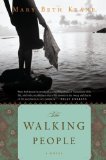Book Club Discussion Questions
In a book club? Subscribe to our Book Club Newsletter and get our best book club books of 2025!
For supplemental discussion material see our Beyond the Book article, Irish Travellers and our BookBrowse Review of The Walking People.
Please be aware that this discussion guide will contain spoilers!
Introduction
Greta Cahill never believed she would leave her village in the west of Ireland until she found herself on a ship bound for New York, along with her sister Johanna and a boy named Michael Ward. Labeled a "softheaded goose" by her family, Greta discovers that in America she can fall in love, raise her own family, and earn a living. Though she longs to return and show her family what she has made of herself, her decision to spare her children knowledge of a secret in her past forces her to keep her life in New York separate from the life she once loved in Ireland, and tears her from the people she holds closest. Even fifty years later, when the Ireland of her memory bears little resemblance to that of the present day, she fears that it is still possible to lose all when she discovers that her children—with the best of intentions—have conspired to unite the worlds she's so carefully kept separate for decades.
Discussion Questions
- Why do you think the author decided to call this book The Walking People? Discuss the possible meanings of the title.
- The Walking People is a family saga that covers the years from 1956 to 2007. Did knowing from the start that Greta and Michael would end up married and settled in America change your experience as a reader?
- In many ways, this is a story about mothers: Greta, Johanna, and their mother, Lilly; Michael and the early loss of his mother; Greta and her own children. What are some of the unusual features of motherhood in the novel? Do you think some of the unique situations make the family bonds stronger or more fragile?
- Michael Ward comes from a "tinker" family of travelers. Greta and Johanna are "country people" who are settled down. What do you think about each group's attitude toward the other's way of life?
- Early in the book, the family discovers that Greta needs glasses, and when she puts them on she notices that "the world looked slightly different" (p. 44). Later, Greta and her family witness the electrification of the city, and in their newly illuminated house they can see cobwebs never detected before. How are these two details symbolic of Greta's shift in worldview when she moves to America? Identify other events of Greta's life that affect her perspective.
- The author uses multiple points of view to tell this story. Why do you think she made this choice? Are there scenes you can imagine from another point of view? Were there particular perspectives you enjoyed more than others?
- What is the significance of Shannon's visit to Ireland from New York City? What do you think it means that her departure left a big hole "shaped just like America" (p. 97)?
- Why do you think Johanna, who had been the most excited about the adventure to America, ends up seeming the most burdened by it?
- Michael's father once told him that women with secrets age too fast (p. 255). Based on the women in The Walking People, would you agree?
- On the family's last evening in their apartment of twenty-two years, Julia discovers the old letters from Aunt Johanna—and discovers a secret about herself. Why do you think she decides to keep her knowledge of this a secret? Do you think her discovery changes the way Julia feels about Greta?
- As Michael prepares to retire, his family and coworkers have noticed subtle signs that he may be developing Alzheimer's. Why is this significant, in light of the fact that Michael believed secrets could age a person?
- The novel ends with Johanna and Tom meeting their sister, Greta. How do you think the meeting will go? Will blood win out over secrets?
- The author begins the book by revealing a glimpse of the day the saga is going to end, and yet in the last chapter, the resolution is left up to the imagination of the reader. Discuss this contrast: the early revelation in the beginning and the unrevealed conclusion. Why do you think the author decided to bookend the novel in this way?
Copyright © 2010 Houghton Mifflin Harcourt
Discussion questions written by Ally Peltier.
Unless otherwise stated, this discussion guide is reprinted with the permission of Mariner Books.
Any page references refer to a USA edition of the book, usually the trade paperback version, and may vary in other editions.
